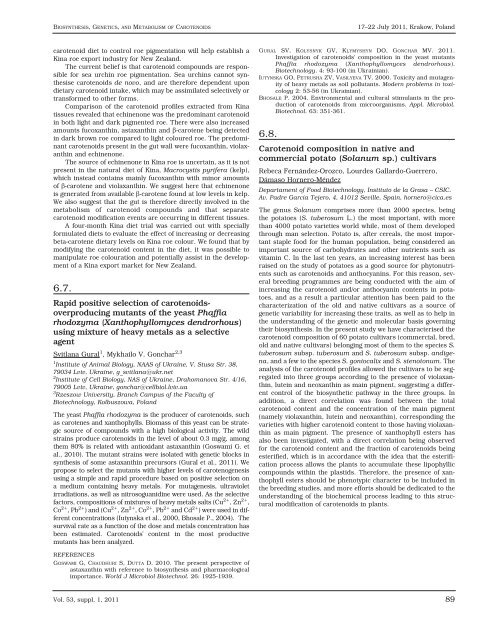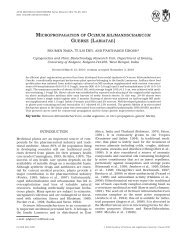ACTA BIOLOGICA CRACOVIENSIA
ACTA BIOLOGICA CRACOVIENSIA
ACTA BIOLOGICA CRACOVIENSIA
Create successful ePaper yourself
Turn your PDF publications into a flip-book with our unique Google optimized e-Paper software.
BIOSYNTHESIS, GENETICS, AND METABOLISM OF CAROTENOIDS<br />
carotenoid diet to control roe pigmentation will help establish a<br />
Kina roe export industry for New Zealand.<br />
The current belief is that carotenoid compounds are responsible<br />
for sea urchin roe pigmentation. Sea urchins cannot synthesise<br />
carotenoids de novo, and are therefore dependent upon<br />
dietary carotenoid intake, which may be assimilated selectively or<br />
transformed to other forms.<br />
Comparison of the carotenoid profiles extracted from Kina<br />
tissues revealed that echinenone was the predominant carotenoid<br />
in both light and dark pigmented roe. There were also increased<br />
amounts fucoxanthin, astaxanthin and β-carotene being detected<br />
in dark brown roe compared to light coloured roe. The predominant<br />
carotenoids present in the gut wall were fucoxanthin, violaxanthin<br />
and echinenone.<br />
The source of echinenone in Kina roe is uncertain, as it is not<br />
present in the natural diet of Kina, Macrocystis pyrifera (kelp),<br />
which instead contains mainly fucoxanthin with minor amounts<br />
of β-carotene and violaxanthin. We suggest here that echinenone<br />
is generated from available β-carotene found at low levels in kelp.<br />
We also suggest that the gut is therefore directly involved in the<br />
metabolism of carotenoid compounds and that separate<br />
carotenoid modification events are occurring in different tissues.<br />
A four-month Kina diet trial was carried out with specially<br />
formulated diets to evaluate the effect of increasing or decreasing<br />
beta-carotene dietary levels on Kina roe colour. We found that by<br />
modifying the carotenoid content in the diet, it was possible to<br />
manipulate roe colouration and potentially assist in the development<br />
of a Kina export market for New Zealand.<br />
6.7.<br />
Rapid positive selection of carotenoidsoverproducing<br />
mutants of the yeast Phaffia<br />
rhodozyma (Xanthophyllomyces dendrorhous)<br />
using mixture of heavy metals as a selective<br />
agent<br />
Svitlana Gural 1 , Mykhailo V. Gonchar 2,3<br />
1Institute of Animal Biology, NAAS of Ukraine, V. Stusa Str. 38,<br />
79034 Lviv, Ukraine, g_svitlana@ukr.net<br />
2Institute of Cell Biology, NAS of Ukraine, Drahomanova Str. 4/16,<br />
79005 Lviv, Ukraine, gonchar@cellbiol.lviv.ua<br />
3Rzeszow University, Branch Campus of the Faculty of<br />
Biotechnology, Kolbuszowa, Poland<br />
The yeast Phaffia rhodozyma is the producer of carotenoids, such<br />
as carotenes and xanthophylls. Biomass of this yeast can be strategic<br />
source of compounds with a high biological activity. The wild<br />
strains produce carotenoids in the level of about 0.3 mg/g, among<br />
them 80% is related with antioxidant astaxanthin (Goswami G. et<br />
al., 2010). The mutant strains were isolated with genetic blocks in<br />
synthesis of some astaxanthin precursors (Gural et al., 2011). We<br />
propose to select the mutants with higher levels of carotenogenesis<br />
using a simple and rapid procedure based on positive selection on<br />
a medium containing heavy metals. For mutagenesis, ultraviolet<br />
irradiations, as well as nitrosoguanidine were used. As the selective<br />
factors, compositions of mixtures of heavy metals salts (Cu 2+ , Zn 2+ ,<br />
Co 2+ , Pb 2+ ) and (Cu 2+ , Zn 2+ , Co 2+ , Pb 2+ and Cd 2+ ) were used in different<br />
concentrations (Iutynska et al., 2000, Bhosale P., 2004). The<br />
survival rate as a function of the dose and metals concentration has<br />
been estimated. Carotenoids' content in the most productive<br />
mutants has been analyzed.<br />
REFERENCES<br />
GOSWAMI G, CHAUDHURI S, DUTTA D. 2010. The present perspective of<br />
astaxanthin with reference to biosynthesis and pharmacological<br />
importance. World J Microbiol Biotechnol. 26: 1925-1939.<br />
Vol. 53, suppl. 1, 2011<br />
GURAL SV, KOLYSNYK GV, KLYMYSHYN DO, GONCHAR MV. 2011.<br />
Investigation of carotenoids' composition in the yeast mutants<br />
Phaffia rhodozyma (Xanthophyllomyces dendrorhous).<br />
Biotechnology. 4: 93-100 (in Ukrainian).<br />
IUTYNSKA GO, PETRUSHA ZV, VASILYEVA TV. 2000. Toxicity and mutagenity<br />
of heavy metals as soil pollutants. Modern problems in toxicology<br />
2: 53-56 (in Ukrainian).<br />
BHOSALE P. 2004. Environmental and cultural stimulants in the production<br />
of carotenoids from microorganisms. Appl. Microbiol.<br />
Biotechnol. 63: 351-361.<br />
6.8.<br />
17–22 July 2011, Krakow, Poland<br />
Carotenoid composition in native and<br />
commercial potato (Solanum sp.) cultivars<br />
Rebeca Fernández-Orozco, Lourdes Gallardo-Guerrero,<br />
Dámaso Hornero-Méndez<br />
Departament of Food Biotechnology, Instituto de la Grasa – CSIC.<br />
Av. Padre García Tejero, 4, 41012 Seville, Spain, hornero@cica.es<br />
The genus Solanum comprises more than 2000 species, being<br />
the potatoes (S. tuberosum L.) the most important, with more<br />
than 4000 potato varieties world while, most of them developed<br />
through man selection. Potato is, after cereals, the most important<br />
staple food for the human population, being considered an<br />
important source of carbohydrates and other nutrients such as<br />
vitamin C. In the last ten years, an increasing interest has been<br />
raised on the study of potatoes as a good source for phytonutrients<br />
such as carotenoids and anthocyanins. For this reason, several<br />
breeding programmes are being conducted with the aim of<br />
increasing the carotenoid and/or anthocyanin contents in potatoes,<br />
and as a result a particular attention has been paid to the<br />
characterization of the old and native cultivars as a source of<br />
genetic variability for increasing these traits, as well as to help in<br />
the understanding of the genetic and molecular basis governing<br />
their biosynthesis. In the present study we have characterised the<br />
carotenoid composition of 60 potato cultivars (commercial, bred,<br />
old and native cultivars) belonging most of them to the species S.<br />
tuberosum subsp. tuberosum and S. tuberosum subsp. andigena,<br />
and a few to the species S. goniocalix and S. stenotonum. The<br />
analysis of the carotenoid profiles allowed the cultivars to be segregated<br />
into three groups according to the presence of violaxanthin,<br />
lutein and neoxanthin as main pigment, suggesting a different<br />
control of the biosynthetic pathway in the three groups. In<br />
addition, a direct correlation was found between the total<br />
carotenoid content and the concentration of the main pigment<br />
(namely violaxanthin, lutein and neoxanthin), corresponding the<br />
varieties with higher carotenoid content to those having violaxanthin<br />
as main pigment. The presence of xanthophyll esters has<br />
also been investigated, with a direct correlation being observed<br />
for the carotenoid content and the fraction of carotenoids being<br />
esterified, which is in accordance with the idea that the esterification<br />
process allows the plants to accumulate these lipophyllic<br />
compounds within the plastids. Therefore, the presence of xanthophyll<br />
esters should be phenotypic character to be included in<br />
the breeding studies, and more efforts should be dedicated to the<br />
understanding of the biochemical process leading to this structural<br />
modification of carotenoids in plants.<br />
89












